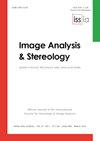LINE SEGMENTS WHICH ARE UNIONS OF TESSELLATION EDGES
IF 1
4区 计算机科学
Q4 IMAGING SCIENCE & PHOTOGRAPHIC TECHNOLOGY
引用次数: 2
Abstract
Planar tessellation structures occur in material science, geology (in rock formations), physics (of foams, for example), biology (especially in epithelial studies) and in other sciences. Their mathematical and statistical study has many aspects to consider. In this paper, line-segments which are either a tessellation edge or a finite union of edges are studied. Our focus is on a sub-class of such line-segments – those we call M-segments – that are not contained in a longer union of edges. These encompass the so-called I-segments that have arisen in many recent tessellation models. We study the expected numbers of edges and cell-sides contained in these M-segments, and the prevalence of these entities. Many examples and figures, including some based on tessellation nesting and superposition, illustrate the theory. M-segments are much more prevalent when a tessellation is not side-to-side, so our paper has theoretical connections with the recent IAS paper by Cowan and Thale (2014); that paper characterised non side-to-side tessellations.线段是镶嵌边的并集
平面镶嵌结构出现在材料科学、地质学(岩层)、物理学(例如泡沫)、生物学(特别是上皮研究)和其他科学中。他们的数学和统计研究有许多方面需要考虑。本文研究了线段的镶嵌边和有限并边。我们的重点是这样的线段的子类-我们称之为m -段-不包含在更长的边的并集中。这些包含了在最近的镶嵌模型中出现的所谓的i段。我们研究了这些m片段中包含的边缘和细胞侧的预期数量,以及这些实体的普遍性。许多例子和图形,包括一些基于镶嵌嵌套和叠加,说明了这一理论。当镶嵌不是侧对侧时,m段更为普遍,因此我们的论文与Cowan和Thale(2014)最近的IAS论文具有理论联系;那篇论文描述了非边对边镶嵌。
本文章由计算机程序翻译,如有差异,请以英文原文为准。
求助全文
约1分钟内获得全文
求助全文
来源期刊

Image Analysis & Stereology
MATERIALS SCIENCE, MULTIDISCIPLINARY-MATHEMATICS, APPLIED
CiteScore
2.00
自引率
0.00%
发文量
7
审稿时长
>12 weeks
期刊介绍:
Image Analysis and Stereology is the official journal of the International Society for Stereology & Image Analysis. It promotes the exchange of scientific, technical, organizational and other information on the quantitative analysis of data having a geometrical structure, including stereology, differential geometry, image analysis, image processing, mathematical morphology, stochastic geometry, statistics, pattern recognition, and related topics. The fields of application are not restricted and range from biomedicine, materials sciences and physics to geology and geography.
 求助内容:
求助内容: 应助结果提醒方式:
应助结果提醒方式:


